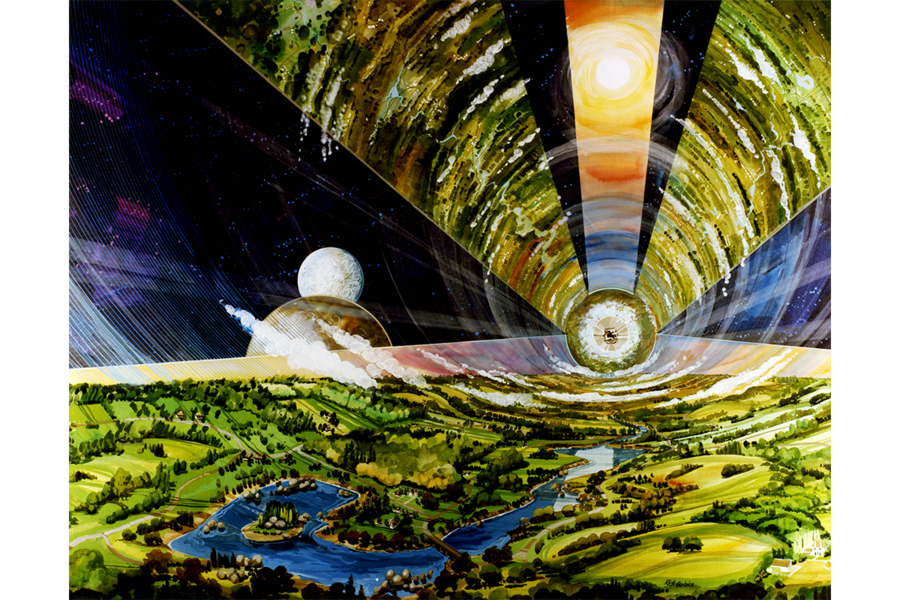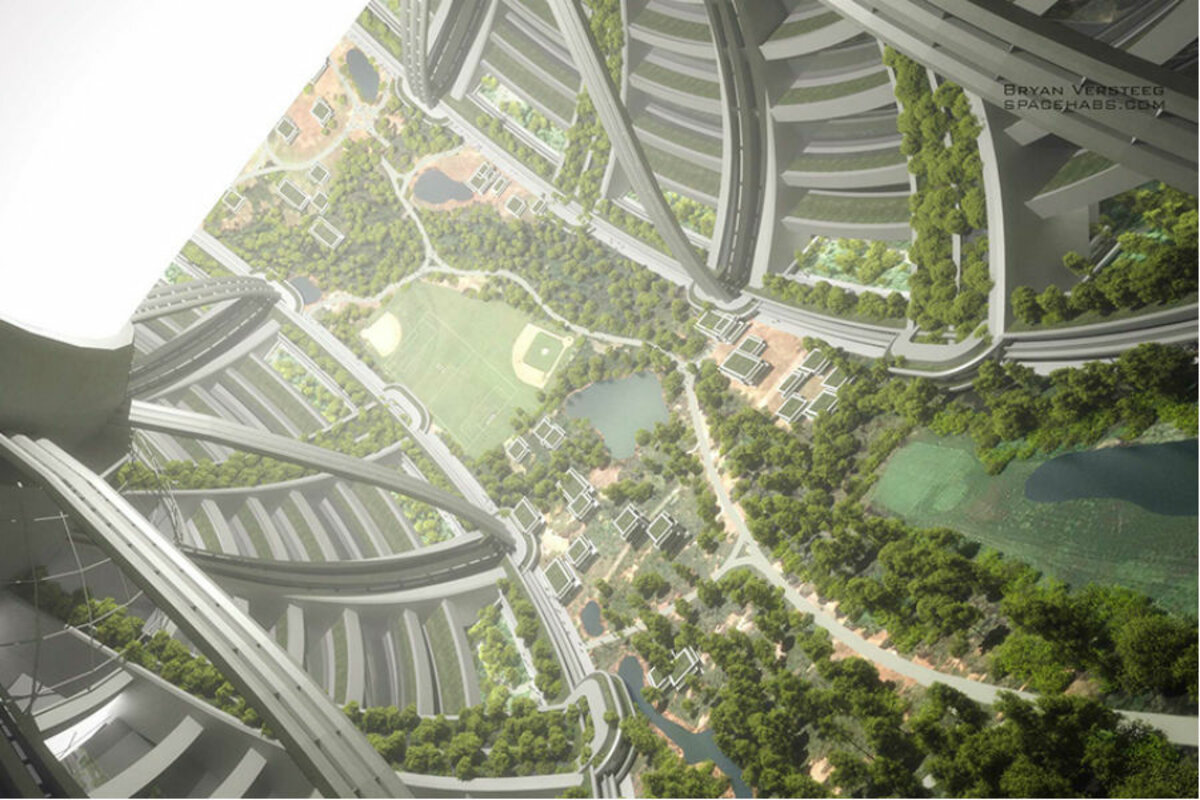To colonize space, start closer to Earth
Loading...
Science fiction has long painted space settlements as inevitable, and talk of Martian brick-building and life-supporting gardens makes it feel closer than ever. But some suggest a simpler path to long-term living in space: orbital habitats near Earth.
SpaceX CEO Elon Musk placed colonization under serious consideration last fall at the International Astronautical Congress in Guadalajara, Mexico, when he announced his intention to bring 1 million people to Mars. But while the presentation was heavy on rocket technicalities, it left out details of how colonists will survive, much less raise children in a high-radiation, low-gravity environment millions of miles away.
NASA contractor and colonization advocate Al Globus says there’s a “radically easier” way: large, round habitats known as O’Neill cylinders that orbit nearby, spinning at just the right speed to create the sensation of normal gravity inside.
“It’s tough to do things 50 million kilometers away,” he says.
Nestled into the protective bubble of Earth’s magnetic field, such a colony could sidestep some of the biological challenges posed by Martian living to focus on the immediate technical problems of space construction and resource recycling. Plus, it would be close. Whether you need a new carbon dioxide scrubber or a quick escape, help would be hours, not months, away.
Indeed, we don't really know how livable we can make Mars. “Musk, NASA headquarters, the movies, all assume that [living in] one-third gravity will be essentially the same as [living in Earth] gravity,” says Chris McKay, a planetary scientist at NASA's Ames Research Center in Mountain View, Calif. “But we have zero data to support that assumption. If it turns out that one-third gravity has the same physiological effects on humans as zero gravity, then Mars is not an option for long-term colonization in the way that Musk is thinking.”
Advocates expect humans to adapt as they have in the past. President of the Mars Society Robert Zubrin compares settling Mars to settling the Earth's Northern Hemisphere: “We evolved in Kenya. Winters would have killed an unshielded human in a single night.”
Princeton physicist Gerard O’Neill first crunched the numbers decades ago for the design that now bears his name, and found no theoretical obstacles to building miles-long habitats free from the punishing forces that batter Earthly structures.
Globus has updated that work with plans for a more modest starting point, a third-of-a-mile-wide cylinder in Equatorial Low Earth Orbit (ELEO), where he envisions it supporting hundreds to thousands of people in a relatively low-radiation environment with Earthlike pseudo-gravity.
But there’s no such thing as a free lunch, especially in space. If concerns about gravity and radiation hinder a Mars colony, material scarcity threatens the creation of orbital settlements. A proper O’Neill cylinder would need millions of tons of rock and metal.
Earth-launched materials could support early, smaller habitats, but more robust colonies would eventually require resources from the moon and nearby asteroids.
“If you want to get less dependent on Earth then you have to develop a transportation system that can get lunar materials.... This is not an impossible task. This is merely difficult,” Globus says with the characteristic optimism of a space engineer.
But schemes to mine and shuttle raw materials seem impracticable to many experts. Dr. Zubrin, for one, is skeptical. “It’s a lot easier to settle a planet than to build one,” he says.
Globus counters that Mars is a big place, and no single site will offer all the necessary materials. “Developing a transportation system on Mars is difficult too.... It’s probably easier on Mars, but on the other hand it’s also 50 million kilometers away,” he explains.
He cautions against what Dr. O’Neill originally called the ”mental hangup” of assuming that worlds are inherently easier to colonize than open space: “You have to build all the same stuff on Mars that you have to build in orbit. You need pressure vessels, you need radiation shielding (which we actually don’t need in ELEO), you need a power system, you need life support.”
Either type of settlement would be highly dependent on Earth for decades to centuries, and, for Globus, the shipping costs alone justify starting closer to home.
Astronomical costs
Neither vision would come cheap. Space agencies will help, but some economic drive is necessary for sustained colonization, and experts have settled on two candidates: entrepreneurial settlers and rich tourists.
The Mars camp favors a pioneering model, much like how Americans spread west. “I think that Mars is gonna be a great place to go,” said Musk at Guadalajara. “It will be the planet of opportunity.”
Zubrin sees Mars in a similar light, a rich but harsh environment ill-suited for vacationing. “Pioneering is for people with a stoic ethic who believe that happiness is a life where you can accomplish great deeds. It will be a real long time before space, even Earth orbit, is a place of safety and comfort.”
He predicts a Mars colony would become "a pressure cooker for invention.”
Globus, however, suggests that ticket sales could drive development. No one knows the size of the space-tourism market, but private individuals have paid tens of millions of dollars to visit the ISS, and more than 600 people have put down large deposits for spots on Virgin Galactic’s waiting list for five minutes in space.
The key to expanding that market, in Globus’s opinion, would be habitats big enough to keep even pampered tourists happy.
"Most people don’t want to live in what basically boils down to some huts connected by tunnels under [30 feet] of stuff [on Mars],” he explains, adding that it would be easier to build large structures in orbit than on Mars.
Globus sees small-scale tourism as the path to large-scale colonies, starting with orbiting hotels much like the ones Bigelow Aerospace is developing. “A hotel is not a whole lot different from a settlement. It has to be pressurized. It might want to recycle its air. It might want to rotate,” he says.
NASA's Dr. McKay points to Antarctica as precedent for tourists paying thousands to visit an inhospitable place: “Their demand and resources enable an infrastructure that enables me to do research there. I love that model. I see that model as applicable to the moon, to space, and maybe even to Mars.”
The big question
Floating cylinders and world-based colonies have at least one thing in common: Both seem highly implausible.
But big thinking demands strong justification. Musk frames the enterprise as a response to existential threats, but McKay questions the assertion that space colonies are the obvious first line of defense, mentioning arctic seed banks and massive underground bunkers as survival strategies that might take priority.
Globus finds the existential argument convincing, but offers a second motivation: a moral responsibility to spread life beyond Earth. “No other species is even remotely in a position to settle space.... It’s our duty.”
Space settlements may be science fiction today, but lunar landers and flying cars once were, too. Classifying a concept as such neither assures its failure nor guarantees its promise. But for now, questions and dreams abound while firm answers are few.
“Long term, we need to determine if [colonization is] possible,” says McKay. “We’re assuming that it’s possible ... but I want to emphasize that we don’t know that it’s possible.”







